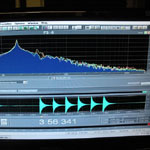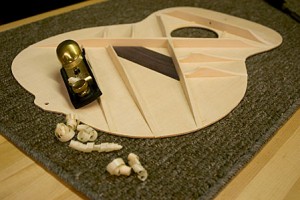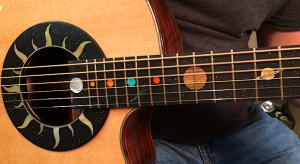
Guitar players and collectors have so many choices available to them. New, used, factory brands, custom hand built…how do you narrow down the choices to the best option for you?
In my opinion, any guitar should be measured by three characteristics: Tone, playability, and appearance. I list these in order of priority. While all three should be excellent, many players go for the eye candy first. But first and foremost a guitar must have great tone to be a great guitar. Abalone trim, perfectly machined parts, and a mirror-like gloss finish have nothing to do with the tone of an instrument. And to get the best from a great sounding guitar, the playability (action) must be buttery smooth. Let’s look briefly at these three characteristics.
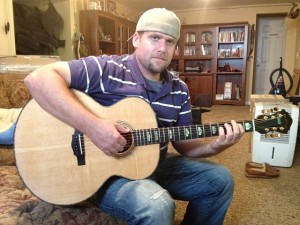
At Dogwood Guitars, tone always comes first. Let’s be honest: We don’t need more guitars, we need more great-sounding guitars. Anyone with the right tools, some talent, and enough experience can make a pretty guitar; those who know how to make a pretty guitar with exceptional tone are in the minority. All Dogwood instruments are individually voiced and tuned during the build process using top wood specifically selected for material properties that directly relate to tone. These include density, modulus, speed of sound, and mass/square inch. The resulting guitars are responsive with great projection, balance, and clarity.
Dogwood Tone: Why it is superior
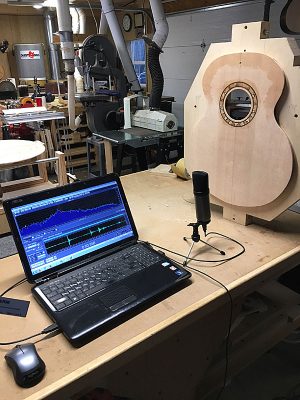 So what do you get when you buy a Dogwood Guitar? To begin, your guitar will have a top that has measured within a narrow range for stiffness-to-weight ratio using software verification. These select tops, along with the backs, are voiced and tuned to specific resonances using a combination of ear and software.This is key! Factories (and many builders) sort tops based on species and appearance, which has no direct bearing on stiffness and weight. This is why you can play seemingly identical brand name guitars and get different tone from each one. Because I individually thin my tops to a deflection, rather than a pre-determined thickness, my tops are lower in mass and more responsive than those thinned to an arbitrary thickness based on species. Many guitars are over-built, with heavy tops and thick braces. This increases mass, damps treble frequencies, and reduces responsiveness. There is no comparison in the tone and responsiveness of a handmade guitar crafted with skilled hands, and a guitar-shaped object mass produced in a factory.
So what do you get when you buy a Dogwood Guitar? To begin, your guitar will have a top that has measured within a narrow range for stiffness-to-weight ratio using software verification. These select tops, along with the backs, are voiced and tuned to specific resonances using a combination of ear and software.This is key! Factories (and many builders) sort tops based on species and appearance, which has no direct bearing on stiffness and weight. This is why you can play seemingly identical brand name guitars and get different tone from each one. Because I individually thin my tops to a deflection, rather than a pre-determined thickness, my tops are lower in mass and more responsive than those thinned to an arbitrary thickness based on species. Many guitars are over-built, with heavy tops and thick braces. This increases mass, damps treble frequencies, and reduces responsiveness. There is no comparison in the tone and responsiveness of a handmade guitar crafted with skilled hands, and a guitar-shaped object mass produced in a factory.
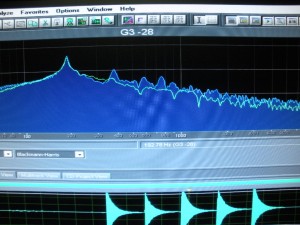
Dogwood guitar tops and backs are tuned to specific target resonances, verified using FFT analysis software. This ensures that the guitar has pure, even tone without dead spots or wolf notes. In a recent study, over half of the guitars from a major California manufacturer had top, back, or air resonances that fell on scale notes, resulting in tonal deficiencies. Another benefit of computer-assisted tuning is consistency. The use of software eliminates guesswork and reduces the subjectivity of the human ear when voicing tops and backs. I’ve had more than one luthier tell me that building guitars is a roll of the dice and you never really know how they will sound until they are done. I don’t think that buyers of handmade instruments want that sort of mystery!
 Let’s talk about playability. I often make the claim that I can make virtually any guitar play better, including brand new factory made guitars. The substance behind this claim is the fact that most factory brands are shipped with less than perfect setups due to unknown variables in handling and storage, and to prevent warranty claims for buzzing strings. Some brands are better than others, but most are sent out with excess relief (up bow) in the neck and slightly high action at the nut and saddle. So universal is this practice that most players and store techs accept excess neck relief as normal. To play at its best, any guitar should have a straight neck, level frets, and the correct action at the nut and saddle. Every Dogwood guitar receives a precision fret dressing (level, crown, and polish) as part of the final setup; many factory-made guitars do not. A correctly set up guitar with truly level frets and a flat neck and low action is easy and enjoyable to play. If such a guitar is treated properly and kept within the appropriate humidity range, it will play with ease and will not have any fret buzzing.
Let’s talk about playability. I often make the claim that I can make virtually any guitar play better, including brand new factory made guitars. The substance behind this claim is the fact that most factory brands are shipped with less than perfect setups due to unknown variables in handling and storage, and to prevent warranty claims for buzzing strings. Some brands are better than others, but most are sent out with excess relief (up bow) in the neck and slightly high action at the nut and saddle. So universal is this practice that most players and store techs accept excess neck relief as normal. To play at its best, any guitar should have a straight neck, level frets, and the correct action at the nut and saddle. Every Dogwood guitar receives a precision fret dressing (level, crown, and polish) as part of the final setup; many factory-made guitars do not. A correctly set up guitar with truly level frets and a flat neck and low action is easy and enjoyable to play. If such a guitar is treated properly and kept within the appropriate humidity range, it will play with ease and will not have any fret buzzing.
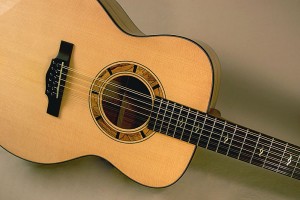
Dogwood Artistry: Dogwood guitars are aesthetically beautiful. I have been collecting unusual wood for three decades and am always looking for high end, unusual sets. Several species of back and side woods are in stock, including figured Maple, Cocobolo, Mahogany, Myrtle, Walnut, and of course Indian Rosewood. Dogwood necks are hand-carved from solid Mahogany blanks laminated with Maple stringers. All Dogwood guitars receive a hand-rubbed high gloss lacquer finish. Many options are available including custom rosettes, Abalone shell body purflings, and custom inlay work.
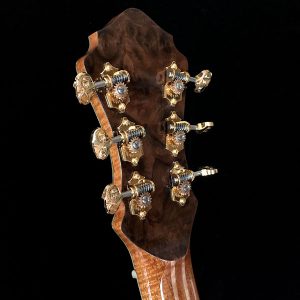 The Dogwood peghead is original and a modern take on a vintage-style design. While many custom builders seem to borrow heavily from each other’s designs and style elments, I wanted to make a peghead and bridge that were reletively unique and a compliment to each other. I prefer to let the wood’s natural beauty speak for itself rather than utilizing bold or garish embelishments. And I prefer to do my inlays, rosettes, and other fine details by hand rather than through the use of CNC machines or lasers. When I say “hand made” it means I used my hands for all the work. My eye for style will guide you toward a completed instrument that all works together as functional fine art, but without excessive, over-the-top decor or heavy elements that detract from elegance.
The Dogwood peghead is original and a modern take on a vintage-style design. While many custom builders seem to borrow heavily from each other’s designs and style elments, I wanted to make a peghead and bridge that were reletively unique and a compliment to each other. I prefer to let the wood’s natural beauty speak for itself rather than utilizing bold or garish embelishments. And I prefer to do my inlays, rosettes, and other fine details by hand rather than through the use of CNC machines or lasers. When I say “hand made” it means I used my hands for all the work. My eye for style will guide you toward a completed instrument that all works together as functional fine art, but without excessive, over-the-top decor or heavy elements that detract from elegance.
Are you ready to sound better? Compare your current acoustic to a Dogwood and you will hear the difference in clarity, balance, responsiveness, and volume. Please contact me, Greg Maxwel, to discuss your dream guitar, and why choosing a Dogwood will prove to be a great decision for you.
Before or after a great guitar you might want to store it in a well secured manner of storage place, if you decide to put it in your garage then have a look at these garage packages to see what you can do about it. You can visit this website at https://titangaragedoors.ca/ to hire them here to get services.
Dogwood Guitars: “Old School Tone… Down to the Bone.”
